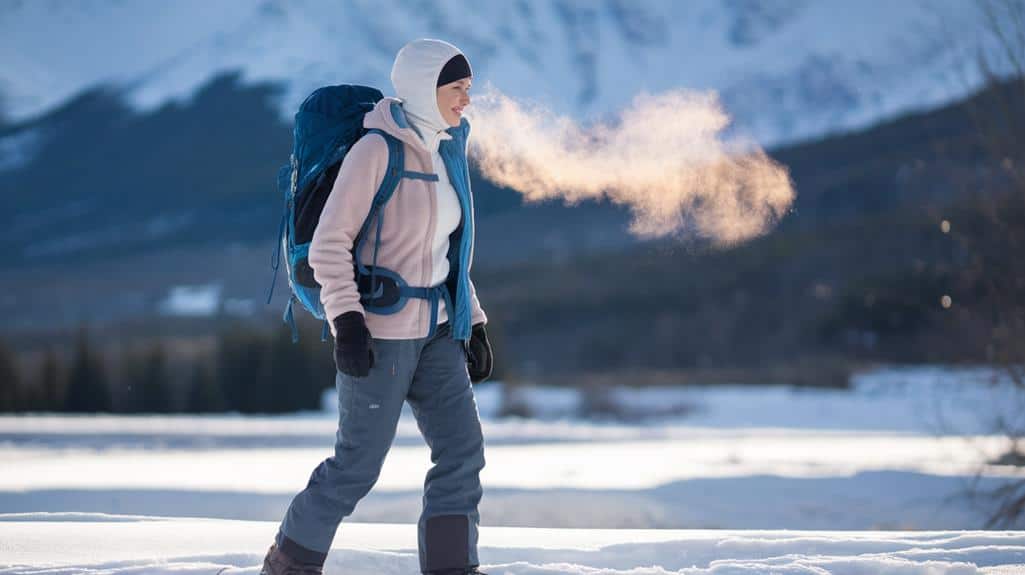
10 Best Cold Weather Layers for Winter Travel Adventures
To conquer winter travel adventures, you'll need these essential cold weather layers: merino wool thermals for a moisture-wicking base, an insulating fleece mid-layer, a down-filled puffer jacket for exceptional warmth-to-weight ratio, and a waterproof shell jacket for protection against the elements. Add insulated snow pants, warm winter boots, thermal socks, and insulated gloves or mittens for complete coverage. Don't forget a neck gaiter or balaclava to shield your face and moisture-wicking underwear as your foundation. Each layer serves a pivotal purpose, from regulating body temperature to repelling water and wind. Mastering this layering system will guarantee your comfort and safety in even the harshest conditions.
In a Nutshell
- Merino wool base layers provide superior insulation and moisture-wicking properties for all-day comfort in cold conditions.
- An insulating fleece mid-layer traps warm air while remaining breathable and versatile for various activities.
- A down-filled puffer jacket offers an unbeatable warmth-to-weight ratio, ideal for cold weather travel.
- A waterproof shell jacket with high breathability protects against harsh elements while allowing moisture to escape.
- Insulated, waterproof snow pants keep legs warm and dry during winter outdoor adventures.
Base Layer: Merino Wool Thermals
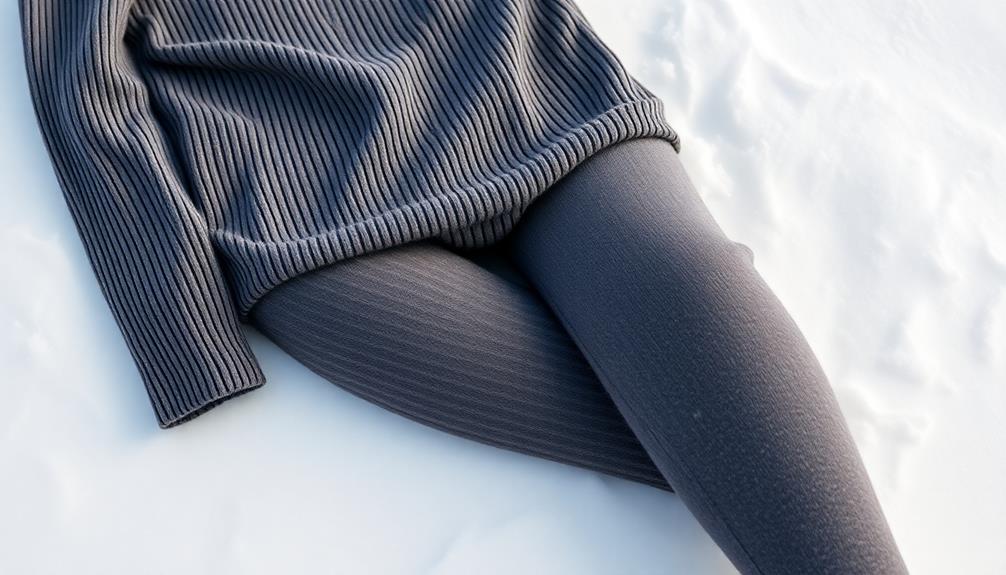
When it comes to winter travel layers, your base layer is the foundation for staying warm and comfortable. Merino wool thermals are an excellent choice for this essential first layer. These natural fibers offer superior insulation, even when wet, and possess remarkable moisture-wicking properties to keep you dry. Unlike synthetic materials, merino wool is naturally odor-resistant, allowing for extended wear between washes. Look for lightweight options, typically around 150-200 gsm, which provide warmth without bulk. Much like sleeping bags for backpacking, merino wool base layers prioritize warmth without excessive weight, making them ideal for travel. They also share the benefit of being highly packable, allowing you to maximize space in your luggage. Opt for a snug fit to maximize heat retention and moisture management. Many high-quality merino base layers feature flat-lock seams to prevent chafing and strategically placed panels for enhanced mobility. When selecting merino wool thermals, consider factors such as fabric weight, fit, and any additional features like thumb holes or zippered necks for added versatility in varying conditions.
Insulating Fleece Mid-Layer
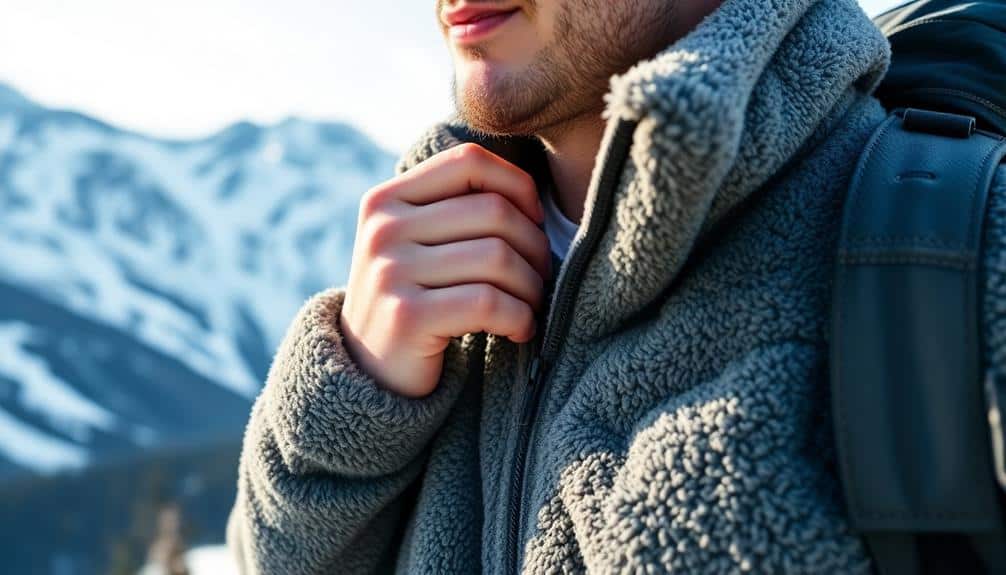
The cozy embrace of a fleece mid-layer forms the integral insulating component of your winter travel wardrobe. This versatile piece traps warm air while wicking moisture away from your body, maintaining ideal temperature regulation. When choosing a fleece for your travel jacket ensemble, consider both functionality and style to guarantee you're prepared for various destinations and activities. Opt for a high-quality polyester fleece with a weight between 200-300 gsm for maximum warmth without bulk. Look for features like flatlock seams to prevent chafing, a full-length zipper for easy ventilation, and zippered pockets to secure essentials. Some top-performing fleece mid-layers incorporate strategically placed panels of wind-resistant fabric or stretchy side panels for enhanced mobility. When selecting your fleece, consider the intended activity level and climate conditions. A quarter-zip pullover style offers versatility for layering, while a full-zip jacket provides more temperature control options. Remember, your fleece mid-layer should fit snugly but not restrict movement.
Down-Filled Puffer Jacket
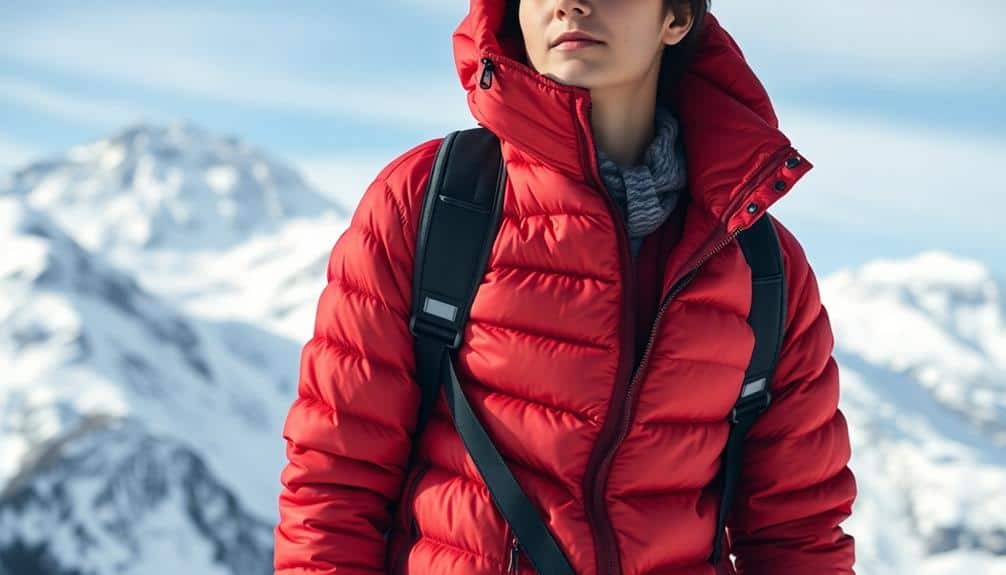
A winter travel essential, the down-filled puffer jacket provides unparalleled warmth-to-weight ratio for cold-weather adventures. You'll appreciate its exceptional insulation properties, trapping body heat efficiently while remaining lightweight and compressible. Look for jackets with high-quality down fill, typically 600-900 fill power, which offers superior loft and thermal efficiency. Opt for models featuring water-resistant or hydrophobic down treatments to maintain insulation in damp conditions. For ideal protection in extreme conditions, consider jackets with multiple waterproof layers and welded seams, similar to high-performance dry bags.
Consider jackets with durable water-repellent (DWR) outer shells to enhance weather protection. Pay attention to features like adjustable hoods, elastic cuffs, and drawcord hems, which help seal out cold air. For versatility, choose a puffer with a two-way zipper and multiple pockets for storing essentials. When selecting your down jacket, prioritize fit that allows for layering underneath without restricting movement, ensuring optimal performance during your winter travels.
Waterproof Shell Jacket
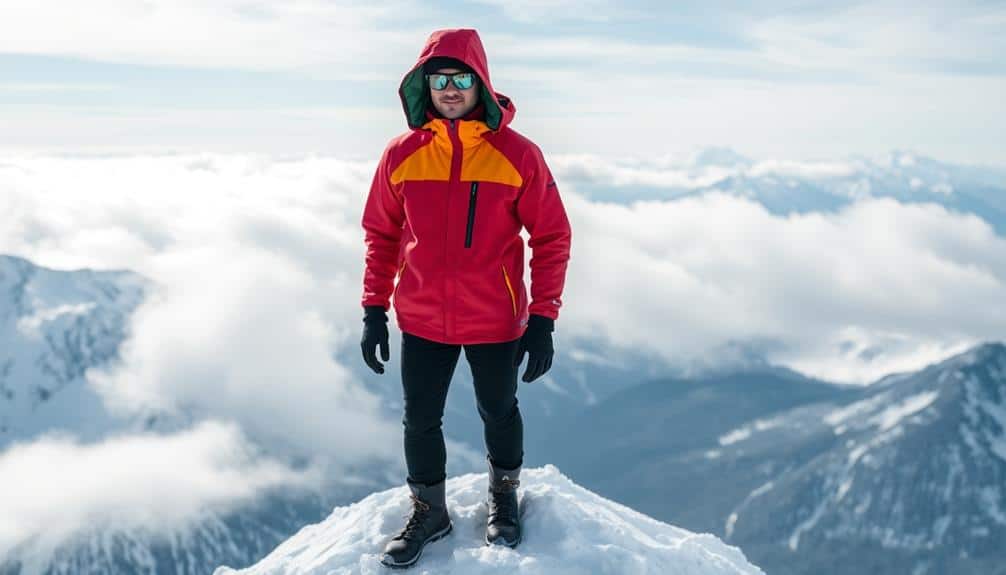
While down-filled puffers excel in insulation, they're not always the best defense against wind and rain. That's where a waterproof shell jacket comes in, providing essential protection against the elements. Look for jackets with a high waterproof rating, ideally 20,000mm or above, and breathability of at least 20,000g/m²/24hr. Features like fully taped seams, water-resistant zippers, and adjustable hoods enhance performance in harsh conditions. Opt for jackets made with advanced materials like Gore-Tex or eVent for superior water resistance and breathability. Consider the jacket's weight and packability, as you'll likely be layering it over other garments. A good shell should have multiple pockets for storage and ventilation options like pit zips. Remember, the right waterproof shell can make or break your winter travel experience, so choose wisely.
Insulated Snow Pants
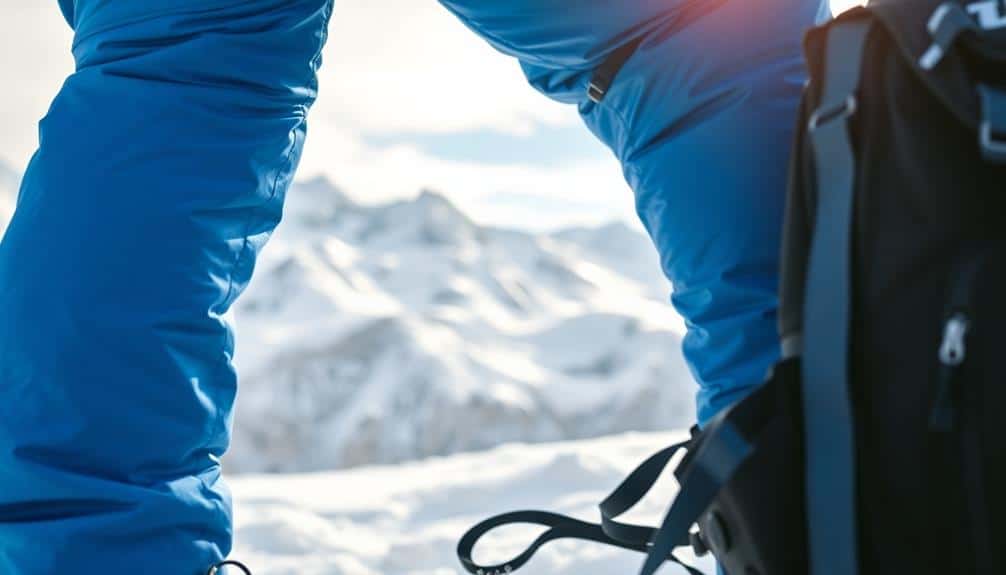
When it comes to winter travel, insulated snow pants step up as an essential layer for your lower body. These specialized pants offer vital protection against cold, wind, and moisture, ensuring your legs stay warm and dry during outdoor activities. Look for high-quality snow pants with features like:
- Waterproof and breathable outer fabric
- Synthetic or down insulation for warmth
- Reinforced knees and seat for durability
- Adjustable waistband and boot gaiters for a secure fit
Opt for pants with articulated knees for enhanced mobility, and consider models with side zips for easy on and off over boots. Insulated snow pants typically come in various weights, allowing you to choose based on your activity level and expected temperatures. For extreme cold, select pants with higher insulation ratings, while lighter options work well for more active pursuits or milder conditions.
Warm Winter Boots
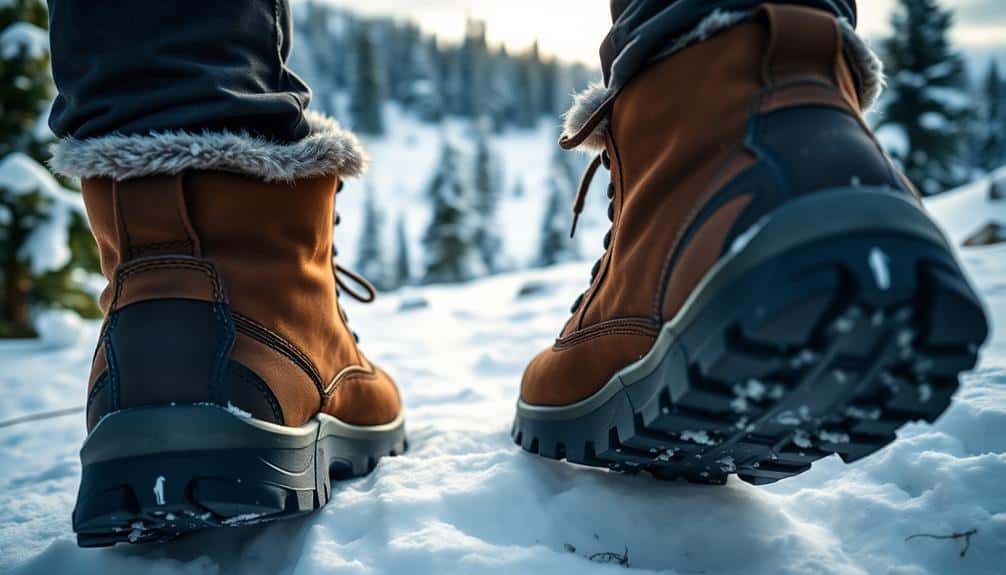
Moving from your legs to your feet, warm winter boots are the foundation of comfortable cold-weather travel. Look for boots with insulation ratings of at least 200 grams, which provide adequate warmth for most winter conditions. Waterproof materials, such as Gore-Tex or treated leather, are essential for keeping your feet dry in snow and slush. Choose boots with aggressive, non-slip outsoles featuring deep lugs for ideal traction on icy surfaces. A height of 8-10 inches offers protection from deep snow, while a cushioned midsole enhances comfort during long walks. Removable liners allow for easy drying and washing. Consider boots with features like gusseted tongues to prevent snow entry, speed-lacing systems for quick adjustments, and reflective elements for visibility in low light conditions. Prioritize a snug fit around the heel to prevent blisters and maintain stability on uneven terrain.
Thermal Socks and Liners
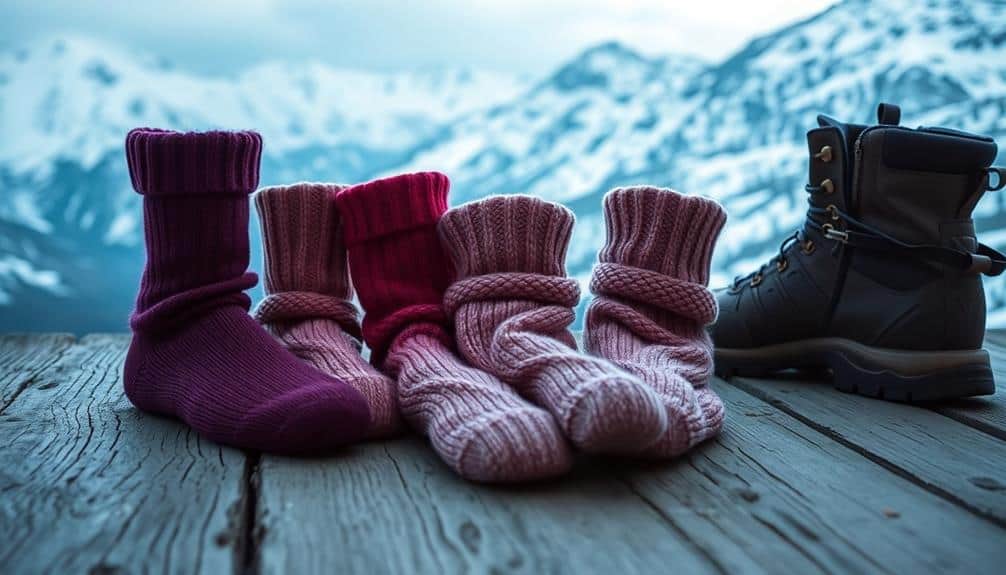
The unsung heroes of winter warmth, thermal socks and liners play an indispensable role in keeping your feet cozy and dry. These specialized layers, often made from moisture-wicking materials like merino wool or synthetic blends, provide essential insulation and temperature regulation. When selecting thermal socks and liners, consider the following key features:
- Thickness: Opt for varying levels based on activity and boot fit
- Material composition: Look for blends that balance warmth and moisture management
- Cushioning: Seek strategic padding for high-impact areas
- Length: Choose crew or knee-high options depending on boot height
For ideal performance, pair a thin liner sock with a thicker outer sock. This combination enhances moisture-wicking capabilities and reduces friction, minimizing the risk of blisters. Remember to avoid cotton, as it retains moisture and can lead to cold, damp feet in winter conditions.
Insulated Gloves or Mittens

Just as thermal socks protect your feet, insulated gloves or mittens safeguard your hands from winter's bite. When selecting hand protection, consider the activity level and temperature range you'll encounter. For extreme cold, opt for mittens, which allow fingers to share warmth. However, gloves offer greater dexterity for tasks requiring fine motor skills. Look for options with waterproof, breathable membranes like Gore-Tex, and insulation materials such as PrimaLoft or Thinsulate. Guarantee a snug fit around the wrist to prevent heat loss and snow entry. Many high-quality gloves feature touchscreen-compatible fingertips, allowing device use without exposure. For versatility, consider convertible mittens with finger flaps. Regardless of style, choose gloves or mittens rated for temperatures at least 10°F below your expected conditions to confirm adequate protection during prolonged outdoor exposure.
Neck Gaiter or Balaclava
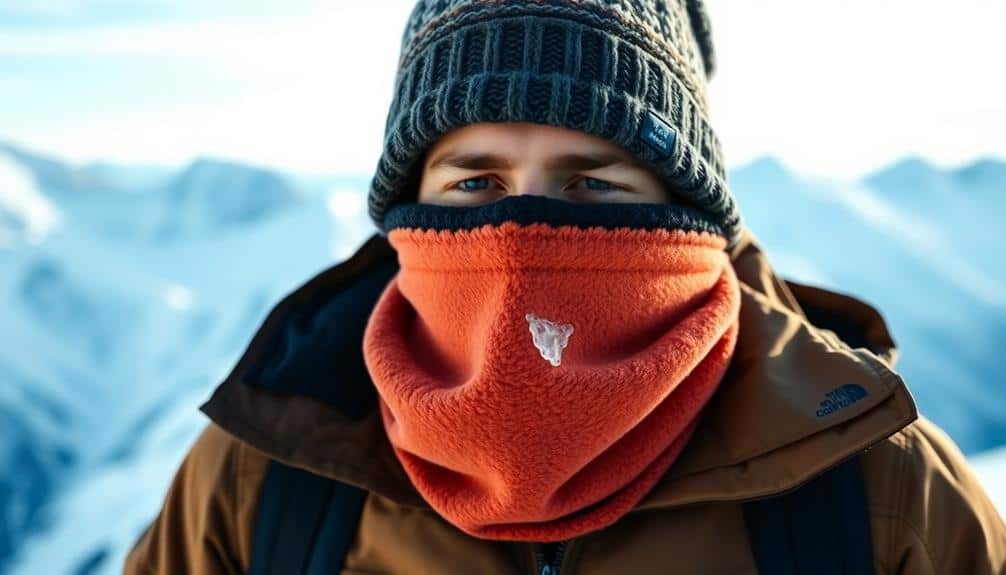
With cold winds whipping around your face, a neck gaiter or balaclava becomes an essential winter travel layer. These versatile accessories offer protection for your neck, chin, and lower face, effectively trapping heat and blocking wind. When choosing between a neck gaiter or balaclava, consider your specific needs and activities.
A high-quality neck gaiter or balaclava should:
- Be made of moisture-wicking, breathable materials like merino wool or synthetic blends
- Offer UV protection for high-altitude or snow-reflected sunlight
- Feature a snug, comfortable fit that doesn't restrict movement
- Provide options for multiple wearing styles (e.g., neck warmer, face mask, headband)
For extreme cold conditions, opt for a balaclava with a longer design that tucks into your jacket collar. Look for models with strategically placed breathable panels to prevent fogging of goggles or glasses during high-intensity activities.
Moisture-Wicking Underwear
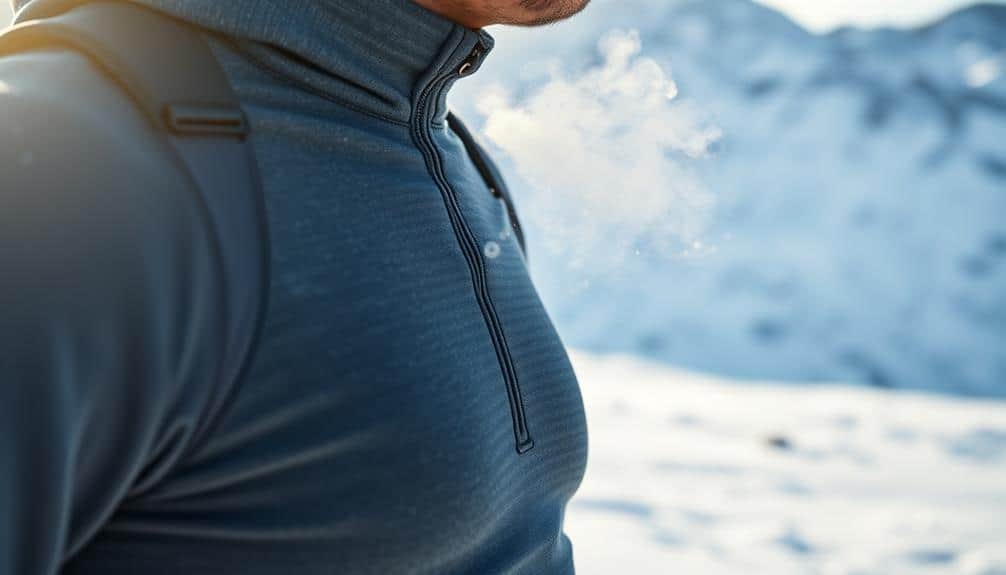
Moving from outerwear to your base layer, moisture-wicking underwear forms the foundation of a well-planned winter travel wardrobe. These garments, typically made from synthetic materials like polyester or nylon blends, are designed to pull sweat away from your skin and disperse it for rapid evaporation. By keeping moisture at bay, they help regulate your body temperature and prevent the chilling effect of damp fabric against your skin.
When selecting moisture-wicking underwear, prioritize options with flat seams to reduce chafing and a snug, but not restrictive, fit. Look for features like antimicrobial treatments to control odor during extended wear and UPF ratings for sun protection. Consider the weight of the fabric—lightweight for moderate activity, midweight for colder conditions or less intense activities. Remember, the effectiveness of your entire layering system depends on this indispensable base layer performing its moisture management duties efficiently.
Frequently Asked Questions
How Do I Pack All These Layers Efficiently for Travel?
To pack layers efficiently for travel, you'll want to employ a few key strategies. Roll your clothes tightly to minimize wrinkles and save space. Use packing cubes to organize and compress your items. Wear your bulkiest layers during transit to free up suitcase space. Opt for versatile, multi-functional pieces that can be mixed and matched. Consider vacuum-sealed bags for extra compression. Finally, prioritize lightweight, packable materials that offer warmth without bulk, such as down or synthetic insulation.
Are There Any Alternatives for People With Wool Allergies?
If you're allergic to wool, you'll find several alternatives for cold weather layering. Synthetic materials like polyester and nylon offer excellent insulation and moisture-wicking properties. Look for fleece jackets, which provide warmth without the itch. Down alternatives, such as PrimaLoft or Thinsulate, offer comparable warmth-to-weight ratios. For base layers, consider merino wool alternatives like bamboo or silk blends. These options will keep you warm and comfortable without triggering allergic reactions, ensuring you're well-prepared for your winter adventures.
How Often Should I Wash Cold Weather Gear During Extended Trips?
You should wash your cold weather gear as needed during extended trips, typically every 3-5 days of active use. However, this frequency can vary depending on your activity level, climate conditions, and the specific materials of your gear. Base layers and socks often require more frequent washing, while outer shells may need less. It's essential to follow manufacturer's care instructions, using appropriate detergents and water temperatures to maintain the gear's performance and longevity.
What's the Best Way to Dry Layers Quickly While Traveling?
To dry layers quickly while traveling, you'll want to maximize airflow and utilize available heat sources. Hang your gear near a heater or radiator, ensuring it's not too close to prevent damage. Use hangers or clothing lines to spread items out, allowing air circulation. If possible, employ a portable fan to increase air movement. For faster results, you can use a hairdryer on low heat, moving it continuously to avoid overheating. In humid environments, consider packing moisture-absorbing packets to expedite drying.
Can These Layers Be Used for Extreme Cold or Just Moderate Winter Conditions?
The layers you've chosen can be used for both moderate and extreme cold conditions, depending on their specific design and materials. For extreme cold, you'll want to opt for high-performance base layers made of merino wool or synthetic fabrics, insulating mid-layers like down or synthetic fill jackets, and waterproof, breathable outer shells. It's essential to select layers with appropriate temperature ratings and to adjust your layering system based on the specific conditions you'll encounter during your travels.
